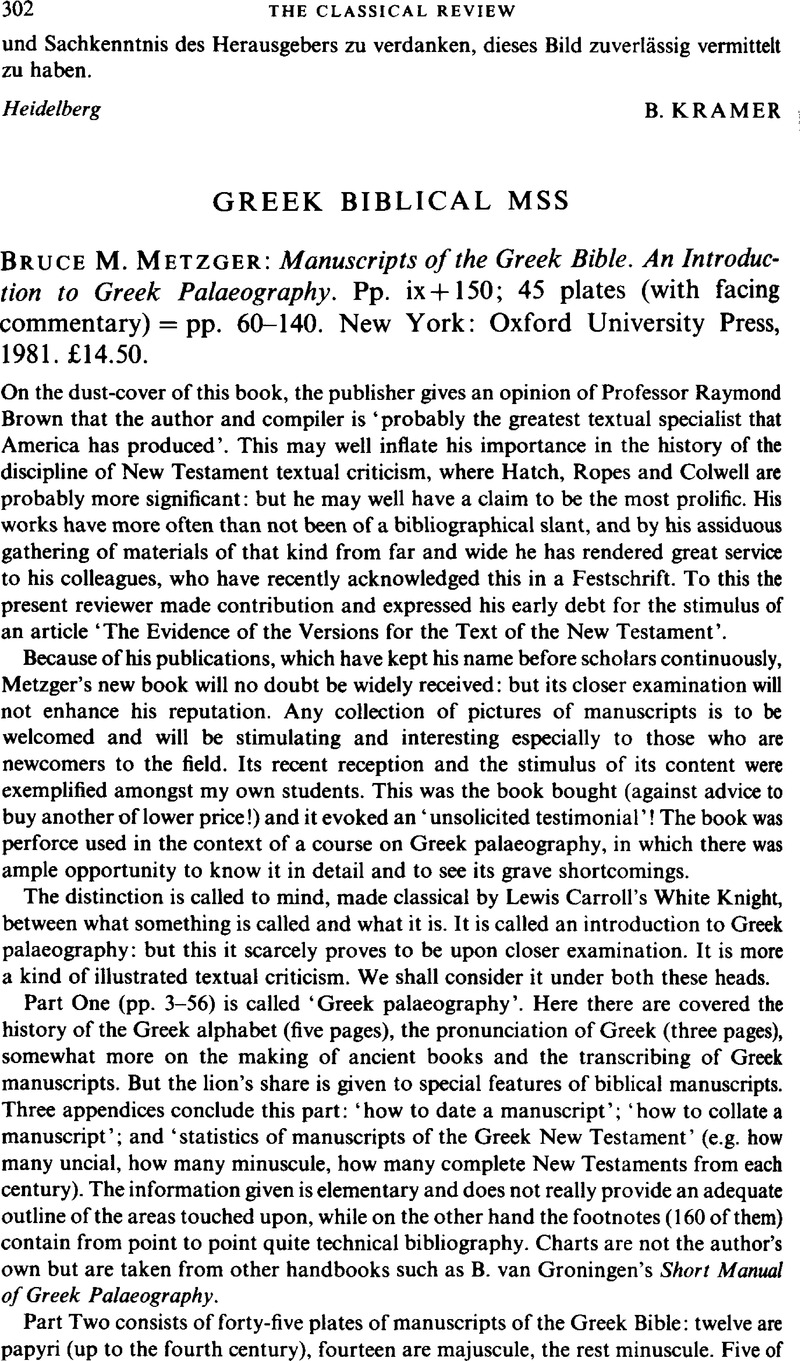No CrossRef data available.
Published online by Cambridge University Press: 16 February 2009

1 Wm. Hatch, H. P., The Principal Uncial Manuscripts of the New Testament (Chicago, 1939).Google Scholar
2 Id. Facsimiles and Descriptions of Minuscule Manuscripts of the New Testament (Cambridge, Mass., 1951).Google Scholar
3 A full account and collation of the Greek cursive Codex Evangelium 604 (with two facsimiles)…by Herman C. Hoskier (London, 1890). The facsimile in point is that which faces the beginning of the collation, between pages cxvi and 1.
4 Cavallo, Guglielmo, Ricerche sulla maiuscola biblica (Firenze, 1967).Google Scholar
5 It is not to be denied that the manuscript continues to present difficulties to the expert: Cavallo, questioned by Paramelle on the origin of the Koridethi manuscript replied ‘Non Le so dare una risposta’ (La paléographie grecque et byzantine, Paris, [1977] 111). But we can make some observations. The form of the letters is essentially that of oval majuscule and its later development into liturgical majuscule. The form of mu is characteristic of the latter, and some instances of the flat-topped rho can also be found. But the distinctiveness of the Koridethi hand is the round epsilon, theta and omicron (although in subscriptions, numerals etc., oval forms are to be found).: a second feature is that rho and hypsilon are generally of equal height to other letters and do not extend below their extent. Some explanation may be suggested although it will certainly not tell us the manuscript's origin. We know from textual data that the exemplar must have had a worthy ancestry. Could the scribe, then, have been copying a text written in biblical majuscule? He was not skilled enough to reproduce it, but the circularity of epsilon, theta and omicron was within his capacity: usually, however, he was dominated by the early liturgical majuscule in which he had some experience. The general regularity of biblical majuscule also led him, in his unsuccessful imitation, to curtail rho and hypsilon in their lower strokes, even though this is not a feature of that canon. Reference should also be made to ![]() X B.
X B. ![]() , Vizantiskij Vremennik 36 (1974), 135 f.Google Scholar
, Vizantiskij Vremennik 36 (1974), 135 f.Google Scholar
6 These scribes may now conveniently be studied in Repertorium der griechischen Kopisten 800–1600. 1. Grossbritannien. Erstellt von E. Gamillscheg, D. Harlfinger, H. Hunger. Austrian Academy of Sciences (1981), s. nn. 98 and 115. But already in Harlfinger's, Specimina griechischer Kopisten der Renaissance: I, Griechen des 15. Jahrhunderts (Berlin, 1974)Google Scholar, which figures in Metzger's bibliography on p. 143, we read concerning Vaticanus graecus 25 (plate 43), written by Xanthopoulos, ‘Xanthopoulos dessen Hand leicht mit der des Emmanuel aus Kpl. verwechselbar ist’, confirming the immediate impression of the representation in the plate. Other hands with similarities are those of Theodoros of Gaza and Michael Apostoles. The former is reproduced in Wilson 74 (Bodleian Auct. T. 4. 16), Harlfinger 10 (Vatic, gr. 1334), Repertorium 128: the latter in Wilson 78 and 79 (Oxford, Corpus Christi College 80: Bodleian D'Orville 117), Repertorium 278, Follieri 63 (Vatic. Urbin. gr. 91) and Wittek 35 and 37 (Bruxelles Bibliothèque royale Sect, des MSS. 1871–77 and id. 11270–75) also give reproductions of manuscripts: Wittek's examples are only ‘attribuable à la main de Michel Apostoles’ but Follieri's example is quoted with a colophon transcribed which specifically names Michael Apostoles. Yet it is not listed as Michael's work by the compilers of the Repertorium. However, these manuscripts too have some features akin to the style of Emmanual. Scrivener could not perhaps know any of these: but they were readily available to Metzger in collections to which he himself draws our attention.
7 The Beginnings of Christianity, Part I. The Acts of the Apostles, edited by F. J. Foakes Jackson and Kirsopp Lake. Volume III. The Text edited by J. H. Ropes (London, 1926), pp. lvi–lxxxiv.
8 On this point there was available Epp, E. J. ‘The twentieth century interlude in New Testament textual criticism’, Journal of Biblical Literature 93 (1974), 386–414CrossRefGoogle Scholar, especially 393–6. More recently Hurtado, Larry W., Text-critical methodology and the pre-Caesarean text: codex W in the gospel of Mark, Studies and Documents, 43 (Grand Rapids, Michigan, 1981).Google Scholar
9 Kirsopp and Silva Lake, Family 13 (The Ferrar group). The text according to Mark, Studies and Documents, 11 (London, 1941). There is much other ancient attestation for the readings.
10 That this is so may be deduced from a study of available facsimiles of Andreas manuscripts and from the comments of Schmid, Studien zur Geschichte des griechischen Apokalypse-Textes 1, 2 (Muenchen, 1955) where a detailed discussion of the Ms tradition may be found (it is referred to by Metzger in the bibliography to plate 42.) The early Georgian translation has the same format with the peculiarity that it gives the text of the Apocalypse before a lemmatized commentary, a format unknown in Greek witnesses. On the relation of the Georgian to the Greek, reference may be made to Birdsall, J. Neville, ‘The Georgian version of the book of Revelation’, Le Muséon 91 (1978), 355–366.Google Scholar
11 Eliot, T. S., ‘The Hippopotamus’, Collected Poems 1909–1935 (London, 1936), 50 (1946 imprint).Google Scholar